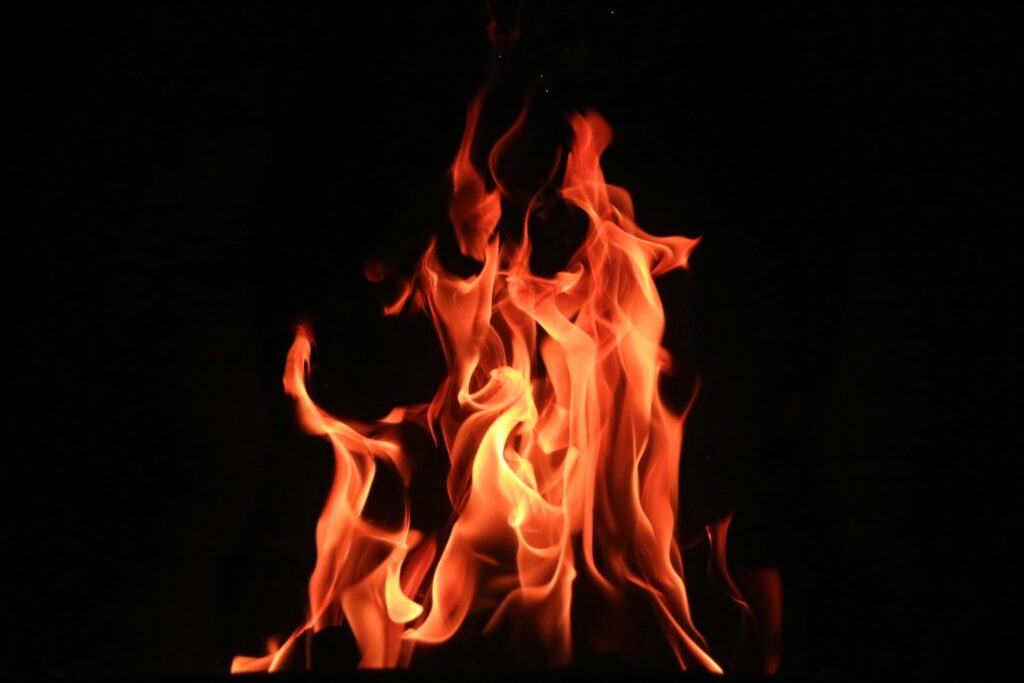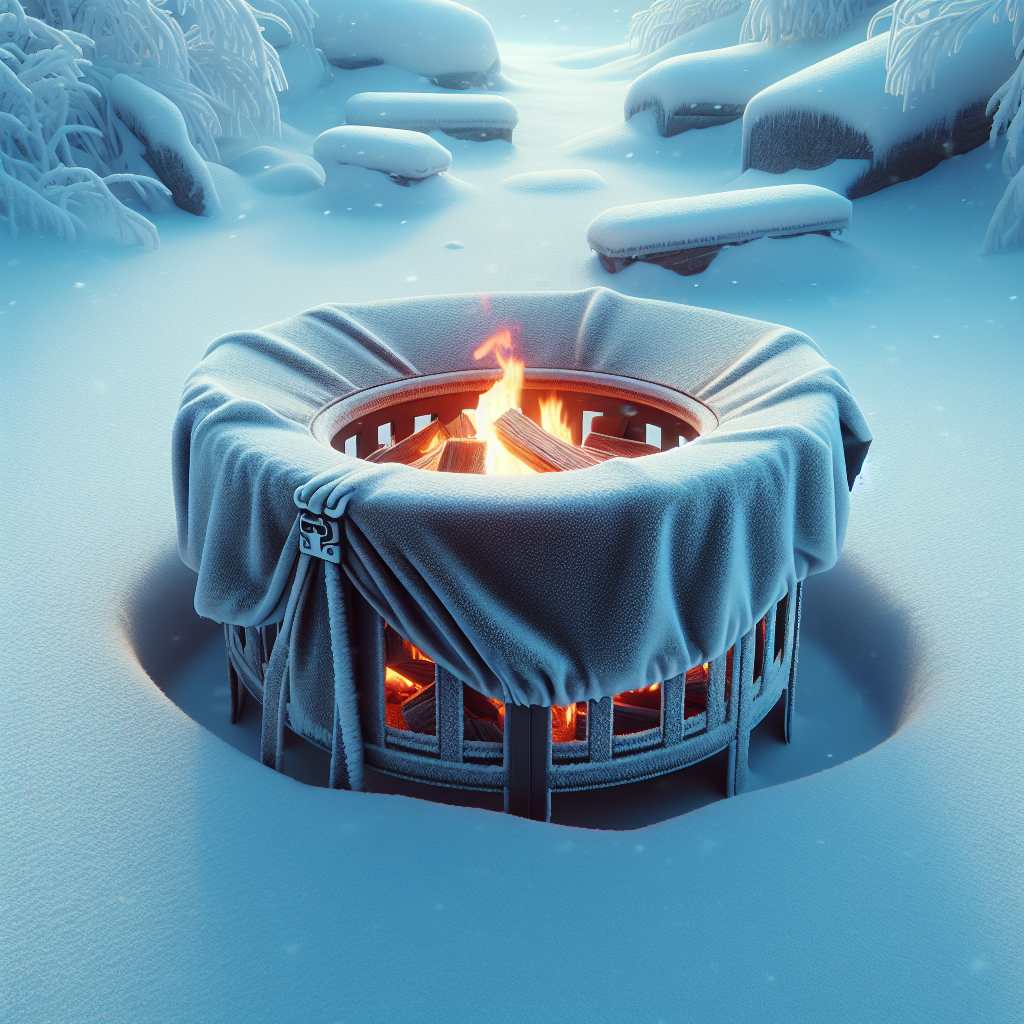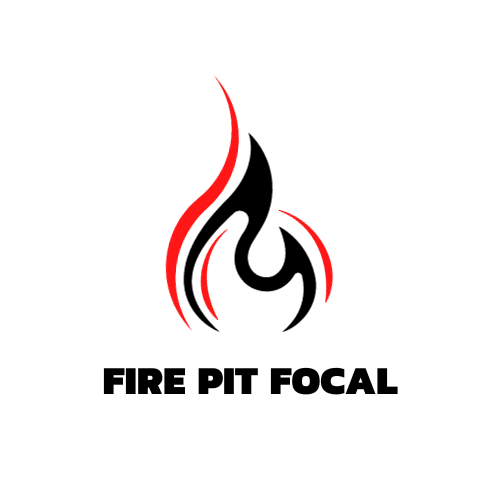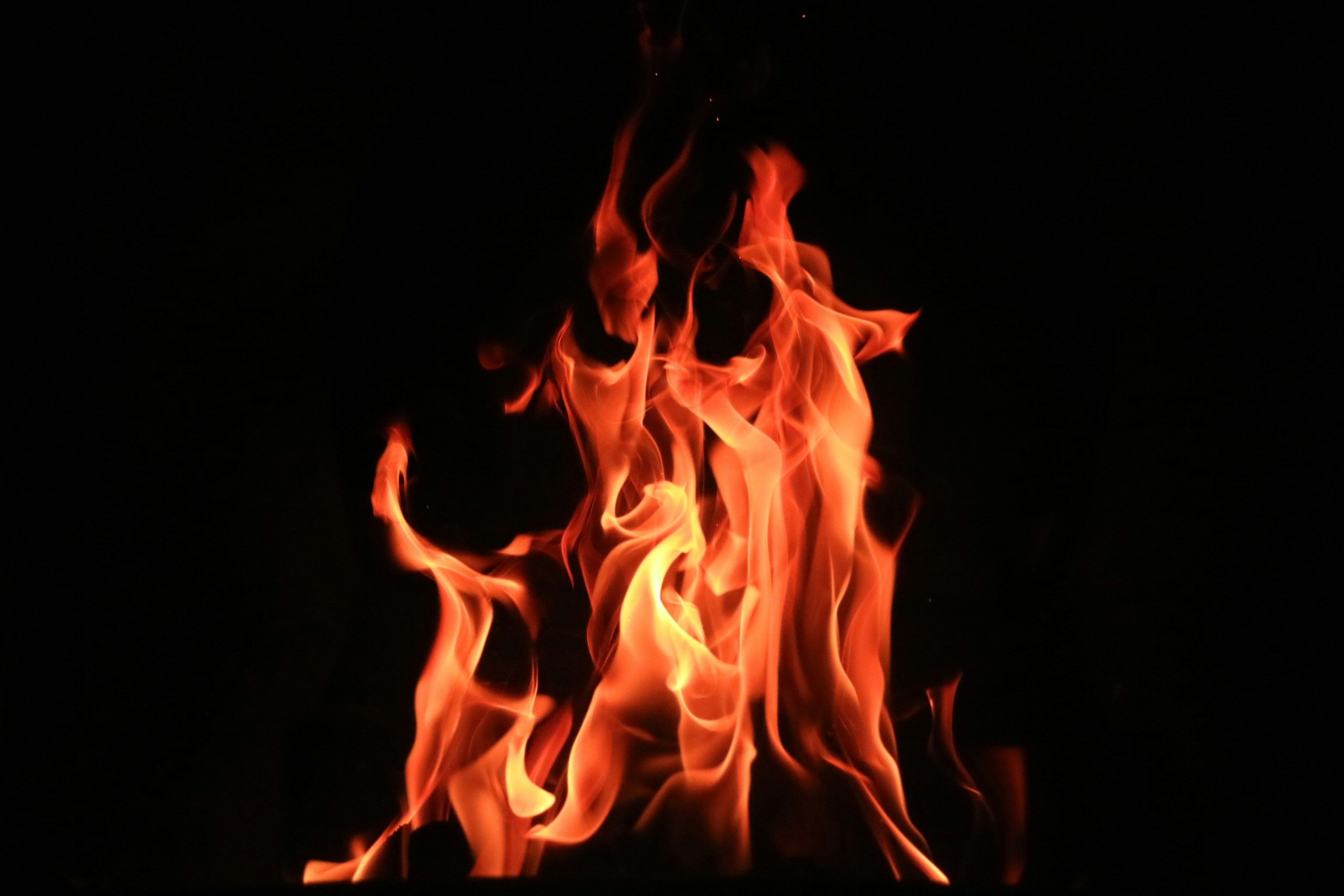Winter is just around the corner, and with the cold weather comes the need to protect your beloved fire pit from the harsh elements. Whether you enjoy cozying up to the warm flames or roasting marshmallows with friends and family, it’s essential to ensure that your fire pit remains in top-notch condition throughout the winter months. But fear not, for we have the answers on how to safeguard your fire pit from snow, rain, and everything in between. From covers to proper storage techniques, we’ve got you covered. Get ready to enjoy winter nights by the fire without worrying about the weather taking a toll on your beloved outdoor feature. This article will guide you through the steps on how to protect your fire pit, so let’s dive right in!

Choosing the Right Material
Consider the Material of the Fire Pit
When it comes to choosing the right material for your fire pit, there are several options to consider. Common materials include stainless steel, cast iron, copper, and stone. Each material has its own advantages and disadvantages, so it’s important to choose one that suits your needs and preferences. Stainless steel, for example, is known for its durability and resistance to corrosion, while stone fire pits offer a natural and rustic look. Consider factors such as heat resistance, maintenance requirements, and aesthetic appeal when deciding on the material for your fire pit.
Opt for a Weather-Resistant Material
To protect your fire pit from the elements, it’s essential to opt for a weather-resistant material. A fire pit that is exposed to rain, snow, and extreme temperatures can quickly deteriorate or become damaged. Look for materials that are specifically designed to withstand outdoor conditions, such as stainless steel or cast iron. These materials have a high resistance to rust and corrosion, making them ideal choices for outdoor fire pits.
Select a Durable Material
Durability is another important factor to consider when choosing the material for your fire pit. A durable fire pit material will ensure that your investment lasts for many years to come. Look for materials that are sturdy and can withstand the heat generated by the fire. Cast iron and stainless steel are known for their durability and can withstand high temperatures without cracking or breaking. Avoid materials that are prone to cracking or breaking, especially in freezing temperatures.
Avoid Materials That Can Crack or Break in Freezing Temperatures
In regions where freezing temperatures are common during the winter months, it’s crucial to avoid materials that can crack or break under these conditions. Some materials, such as ceramic or concrete, are more prone to cracking when exposed to extreme cold. Instead, opt for materials that have a higher resistance to freezing temperatures, such as stainless steel or cast iron. By choosing a material that can withstand freezing temperatures, you can prevent potential damage to your fire pit and ensure its longevity.
Covering the Fire Pit
Invest in a Fire Pit Cover
One of the best ways to protect your fire pit from the elements during the winter is to invest in a high-quality fire pit cover. A cover acts as a shield, preventing rain, snow, and debris from accumulating on the surface of the fire pit. By keeping the fire pit covered when not in use, you can greatly extend its lifespan and reduce the need for frequent cleaning and maintenance.
Choose a Cover Specific to Your Fire Pit Shape and Size
When purchasing a fire pit cover, it’s important to choose one that is specifically designed for your fire pit’s shape and size. An ill-fitting cover may not provide adequate protection and can easily be blown off by strong winds. Take accurate measurements of your fire pit, including its diameter and height, and select a cover that matches these dimensions. A properly fitted cover will offer maximum protection and ensure that your fire pit remains in top condition.
Ensure the Cover is Waterproof and UV Resistant
Since your fire pit will be exposed to rain, snow, and sunlight, it’s essential to choose a cover that is waterproof and UV resistant. A waterproof cover will prevent water from seeping through and causing damage to the fire pit, while UV resistance will protect it from the harmful effects of the sun’s rays. Look for covers made from durable materials that are specifically designed for outdoor use. These covers will offer superior protection and ensure that your fire pit remains in pristine condition throughout the winter months.
Secure the Cover Properly to Prevent Wind Damage
Even with a high-quality cover, strong winds can pose a threat to your fire pit. To prevent wind damage, it’s important to secure the cover properly. Look for covers that come with straps or drawstrings that can be tightened to keep the cover in place. Additionally, consider using weights or anchors to further secure the cover and prevent it from being lifted off by gusts of wind. By taking these precautions, you can ensure that your fire pit remains protected even during the windiest of days.
Storing the Fire Pit
Consider Disassembling the Fire Pit
If you live in an area with particularly harsh winters, it may be beneficial to consider disassembling your fire pit and storing it indoors for the season. Disassembling the fire pit will protect it from exposure to extreme temperatures, snow, and ice. Follow the manufacturer’s instructions for disassembling the fire pit, and remember to label and store all components properly for easy reassembly in the spring.
Store the Fire Pit in a Dry and Sheltered Area
When storing your fire pit, it’s important to choose a dry and sheltered area. Moisture can cause damage to the fire pit, especially if it freezes and expands. Find a location such as a garage, shed, or basement where the fire pit will be protected from rain, snow, and excessive humidity. Ensure that the storage area is well-ventilated to prevent the buildup of moisture and condensation.
Clean and Dry the Fire Pit Before Storage
Before storing your fire pit for the winter, it’s crucial to clean and dry it thoroughly. Remove any ash, debris, or leftover fuel from the fire pit. Use a wire brush or abrasive sponge to scrub away any stubborn stains or residues. Once the fire pit is clean, allow it to dry completely to prevent the growth of mold or mildew. A dry fire pit is less likely to develop rust or other forms of corrosion during storage.
Use a Protective Covering During Storage
To provide an extra layer of protection, consider using a protective covering over your disassembled fire pit during storage. This can help prevent dust, dirt, and other debris from accumulating on the fire pit, ensuring that it remains clean and in good condition. Choose a cover made from a breathable material to allow for proper airflow and ventilation. Avoid using plastic covers as they can trap moisture and lead to the growth of mold or mildew.
Elevating the Fire Pit
Raise the Fire Pit off the Ground
Elevating your fire pit off the ground can help protect it from moisture and prevent damage to the underlying surface. Moisture that accumulates underneath a fire pit can lead to rust, rot, or other forms of corrosion. By raising your fire pit, you create an air gap that allows for proper ventilation and reduces the risk of moisture buildup.
Place the Fire Pit on a Stable Base
A stable base is essential to ensure the safety and longevity of your fire pit. When placing your fire pit, choose a level area with a sturdy and non-flammable surface. Popular choices for fire pit bases include concrete pads, pavers, or gravel. Avoid placing your fire pit directly on grass or wood as these materials can pose a fire hazard and may also be more prone to moisture accumulation.
Utilize Fire Pit Feet or Bricks
To further elevate your fire pit and provide additional protection, consider using fire pit feet or bricks. These can be placed underneath the fire pit to raise it even higher off the ground. Fire pit feet or bricks are typically made from heat-resistant materials such as cast iron or stainless steel, ensuring that they can withstand the high temperatures generated by the fire. By using these accessories, you can create a safer and more stable environment for your fire pit.
Prevent Moisture Accumulation Underneath
Moisture accumulation underneath a fire pit can cause various issues, including rust, rot, and damage to the underlying surface. To prevent moisture buildup, ensure proper drainage around the fire pit area. Avoid placing the fire pit in low-lying areas that are prone to collecting water. Additionally, consider using a moisture barrier, such as a layer of gravel or sand, underneath the fire pit to create a protective barrier between the fire pit and the ground.

Keeping the Fire Pit Dry
Drain Rainwater and Snow from the Fire Pit
During the winter months, it’s important to drain any rainwater or melted snow that accumulates in your fire pit. Excess moisture can damage the fire pit and lead to rust or corrosion. To drain the water, simply tilt the fire pit slightly to allow the water to flow out through the drainage holes or spout. Once the water has drained, dry the fire pit thoroughly before using it again.
Cover the Fire Pit When Not in Use
Covering the fire pit when it’s not in use is a simple yet effective way to keep it dry. A fire pit cover will prevent rain, snow, and debris from entering the fire pit, ensuring that it stays clean and dry. Remember to choose a cover that is waterproof and UV resistant for maximum protection. By covering your fire pit when it’s not in use, you can significantly extend its lifespan and reduce the need for frequent cleaning and maintenance.
Regularly Remove Moisture Build-up
Even with a cover, moisture can sometimes accumulate inside the fire pit. Regularly inspect the fire pit for any signs of moisture and remove it promptly. Use a towel or cloth to soak up any water or moisture that may have entered the fire pit. Additionally, consider using a moisture-absorbing product, such as silica gel packets or moisture-absorbing crystals, inside the fire pit to help keep it dry.
Ensure Proper Ventilation to Prevent Condensation
Condensation can occur inside the fire pit when there is inadequate ventilation or airflow. To prevent condensation, ensure that your fire pit has proper ventilation. This can be achieved by leaving the fire pit uncovered when it’s not in use or using a cover that allows for airflow. Adequate ventilation will help reduce moisture buildup and prevent the growth of mold or mildew inside the fire pit.
Preventing Rust and Corrosion
Apply a Protective Barrier to Metal Fire Pits
Metal fire pits, such as those made from stainless steel or cast iron, are prone to rust and corrosion if not properly protected. To prevent rust and corrosion, consider applying a protective barrier to your metal fire pit. There are various products available, such as heat-resistant paint or specialized coatings, that can help create a barrier between the metal and the elements. Follow the manufacturer’s instructions for proper application and reapply the protective barrier as needed.
Use Rust-Resistant Materials
Choosing rust-resistant materials for your fire pit can help prevent rust and corrosion over time. Stainless steel and cast iron are known for their resistance to rust, making them excellent choices for outdoor fire pits. Additionally, consider opting for fire pits with a powder-coated finish, as the powder coating can provide an extra layer of protection against rust and corrosion. Regular cleaning and maintenance are still important to ensure the longevity of your rust-resistant fire pit.
Keep the Fire Pit Clean
Regularly cleaning your fire pit is crucial for preventing rust and corrosion. Remove any ash, debris, or leftover fuel from the fire pit after each use. Use a wire brush or abrasive sponge to scrub away any stubborn stains or residues. Rinse the fire pit with water and allow it to dry completely before covering or storing it. By keeping your fire pit clean, you can remove any potential contributors to rust and corrosion and maintain its overall condition.
Regularly Inspect and Maintain the Fire Pit
Regular inspections and maintenance are essential for ensuring the longevity of your fire pit. Check your fire pit periodically for any signs of rust, corrosion, or damage. If you notice any issues, address them promptly to prevent further deterioration. Replace any damaged or worn-out components, such as grates or screens, to prevent rust from spreading to other parts of the fire pit. By maintaining and caring for your fire pit regularly, you can minimize the risk of rust and corrosion and extend its lifespan.

Minimizing Exposure to Moisture
Choose an Appropriate Fire Pit Location
Choosing the right location for your fire pit can help minimize its exposure to moisture. Avoid placing your fire pit in low-lying areas or near water sources where rainwater or snowmelt may collect. Instead, opt for a higher and well-drained area where water is less likely to accumulate. Consider the natural drainage patterns of your outdoor space and select a location that allows for proper water runoff.
Create a Shelter or Roof Over the Fire Pit
If you live in an area with frequent rainfall or snowfall, consider creating a shelter or roof over your fire pit to protect it from moisture. A roof can shield the fire pit from direct exposure to rain or snow, keeping it dry and preventing potential damage. You can build a permanent structure, such as a gazebo or pergola, or use a temporary canopy or cover. Ensure that the shelter is tall enough to allow for proper ventilation and airflow.
Avoid Leaving Water or Ice on the Fire Pit
After draining any water from your fire pit, be sure to remove any remaining water or ice on the surface. Leaving water or ice on the fire pit can lead to the accumulation of moisture, which can cause rust or corrosion over time. Use a towel or cloth to dry the surface of the fire pit thoroughly. By removing any water or ice, you can protect your fire pit from unnecessary exposure to moisture.
Monitor and Remove any Snow Accumulation
During the winter months, it’s important to regularly monitor your fire pit for any snow accumulation. Snow can trap moisture and cause damage to the fire pit if left unattended. Use a brush or shovel to carefully remove snow from the fire pit’s surface. Be gentle to avoid scratching or damaging the fire pit. Once the snow has been cleared, take the necessary steps to ensure that the fire pit is dry before using or covering it.
Maintaining Proper Airflow
Clear Debris and Obstructions
To maintain proper airflow in your fire pit, it’s important to regularly clear away any debris or obstructions. Leaves, twigs, and other debris can accumulate inside the fire pit and block the air vents, preventing adequate airflow. Use a brush or broom to sweep away any debris from the fire pit’s interior and vents. By keeping the air vents clear, you can ensure that your fire pit burns efficiently and prevent the buildup of smoke or harmful gases.
Check and Clean the Fire Pit Vents
The vents on your fire pit play a crucial role in maintaining proper airflow. Over time, these vents can become clogged with ash, soot, or debris, restricting the flow of air. Regularly check and clean the vents to ensure that they are clear and free from any blockages. Use a brush or compressed air to remove any buildup of ash or debris. Adequate ventilation will not only improve the performance of your fire pit but also reduce the risk of smoke and carbon monoxide buildup.
Ensure Proper Ventilation for Wood-Burning Fire Pits
For wood-burning fire pits, proper ventilation is essential for efficient burning and the prevention of smoke and carbon monoxide buildup. Ensure that your fire pit has enough air vents to allow for a steady flow of oxygen. The positioning of the air vents is also important – they should be strategically placed to encourage the circulation of air and feed the fire with oxygen. Regularly check and clean the vents to ensure that they are functioning properly.
Avoid Using Fire Pit Covers During Operation
Although fire pit covers are invaluable for protecting your fire pit from the elements, it’s important to avoid using them during operation. Using a cover while the fire pit is in use can restrict airflow and cause the fire to burn inefficiently. This can lead to the buildup of smoke, harmful gases, or excessive heat. Always remove the cover before starting a fire and ensure that there is proper ventilation to support a healthy and safe fire.

Regular Inspection and Maintenance
Inspect for Cracks, Breaks, or Loose Parts
Regularly inspect your fire pit for any signs of cracks, breaks, or loose parts. Over time, exposure to heat and the elements can cause wear and tear, potentially compromising the structural integrity of your fire pit. Inspect the fire pit’s body, legs, grates, screens, and any other components for any damage. If you notice any cracks, breaks, or loose parts, address them promptly to prevent further issues and ensure the safety of your fire pit.
Repair or Replace Damaged Components
If you discover any damaged components during your inspection, it’s essential to repair or replace them as needed. Cracked or broken parts can lead to a less efficient fire, as well as potential safety hazards. Depending on the severity of the damage, you may be able to repair the component yourself using appropriate materials or seek professional assistance. If the damage is beyond repair, consider replacing the component to maintain the functionality and safety of your fire pit.
Clean and Remove Ash and Debris
Regular cleaning and maintenance are vital for keeping your fire pit in good condition. After each use, remove any ash, debris, or leftover fuel from the fire pit. Use a brush or shovel to sweep the interior of the fire pit, ensuring that all remnants are removed. Dispose of the ash and debris properly, following any local regulations or guidelines. A clean fire pit not only looks appealing but also functions optimally and reduces the risk of rust or corrosion.
Check Gas Lines and Connections (for Gas Fire Pits)
If you have a gas fire pit, it’s important to regularly check the gas lines and connections for any leaks or damage. Inspect the gas lines for signs of wear, such as cracks or holes, and ensure that the connections are securely fastened. If you detect any leaks or suspect any issues with the gas lines or connections, it’s crucial to address them immediately. Consult a professional if necessary to ensure that your gas fire pit remains safe and in good working order.
Proper Usage and Precautions
Follow the Manufacturer’s Guidelines
To protect your fire pit and ensure safe usage, it’s essential to follow the manufacturer’s guidelines. The manufacturer’s guidelines provide valuable information on proper installation, usage, and maintenance of your fire pit. Familiarize yourself with these guidelines and adhere to them at all times. Failure to follow the manufacturer’s recommendations may result in damage to your fire pit or pose a safety risk.
Use the Fire Pit Safely and Responsibly
Using a fire pit safely and responsibly is crucial to prevent accidents and injuries. Keep a safe distance between the fire pit and flammable materials, such as plants, furniture, or structures. Never leave the fire pit unattended, especially when children or pets are present. Use a fire pit screen or spark guard to prevent embers from escaping and starting a fire. Always have a fire extinguisher or a bucket of water nearby for emergencies.
Avoid Overloading the Fire Pit
Overloading the fire pit with excessive fuel can lead to dangerous situations. Only use the recommended amount of fuel specified by the manufacturer. Adding too much fuel to the fire pit can cause flare-ups, excessive heat, or uncontrollable flames. It’s important to maintain a manageable fire that is within the designated fire pit capacity. This not only ensures the safety of everyone around but also extends the lifespan of your fire pit.
Take Precautions to Prevent Fire Hazards
To protect your fire pit from potential fire hazards, take necessary precautions. Keep flammable materials, such as wood piles or propane tanks, at a safe distance from the fire pit. Ensure that the area around the fire pit is clear of any debris or combustible materials. Never use flammable liquids or accelerants to start a fire in the fire pit, as this can lead to uncontrollable flames or explosions. By taking these precautions, you can enjoy your fire pit safely and minimize the risk of fire accidents.
In conclusion, protecting your fire pit from the elements in the winter requires careful consideration of the material, proper covering, storage, elevation, and maintenance. By selecting a weather-resistant and durable material, investing in a high-quality cover, storing the fire pit in a dry area, elevating it off the ground, and keeping it dry and well-ventilated, you can ensure the longevity and safety of your fire pit. Regular inspections, proper usage, and precautions, along with thorough cleaning and maintenance, are essential for keeping your fire pit in excellent condition. By following these guidelines and taking the necessary steps to protect your fire pit, you can enjoy cozy outdoor gatherings all year round.



